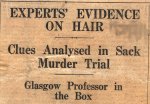The Medico-Legal Examination of Hairs and Fibres
 John Glaister Junior had a special interest in the study of hairs and fibres. This subject he explored in his DSc thesis submitted to the University of Glasgow in 1927. Glaister collected samples of hairs of mammals from zoos and museums, and then took photomicrographs of each specimen. The photomicrographs were then mounted in an Album which contained over one hundred images of hairs taken from a hamster, leopard and a horse for example [see Ref. GUAFM/4/2/3].
John Glaister Junior had a special interest in the study of hairs and fibres. This subject he explored in his DSc thesis submitted to the University of Glasgow in 1927. Glaister collected samples of hairs of mammals from zoos and museums, and then took photomicrographs of each specimen. The photomicrographs were then mounted in an Album which contained over one hundred images of hairs taken from a hamster, leopard and a horse for example [see Ref. GUAFM/4/2/3].  In 1931, Glaister's work on hairs was published in the form of an atlas entitled A Study of Hairs and Wools, which contained circa 1700 photomicrographs. According to Glaister: 'The avenue of medico-legal investigation demands an exhaustive study of animal and human hairs, if an opinion regarding the source of hair is to be expressed.
In 1931, Glaister's work on hairs was published in the form of an atlas entitled A Study of Hairs and Wools, which contained circa 1700 photomicrographs. According to Glaister: 'The avenue of medico-legal investigation demands an exhaustive study of animal and human hairs, if an opinion regarding the source of hair is to be expressed.  For the purpose of identification, it is essential that the examiner should have at hand a comprehensive collection of known hairs for comparison. By this means, it becomes a simpler matter to contrast the detailed structure of the unknown specimen with that of fibres of known origin.
For the purpose of identification, it is essential that the examiner should have at hand a comprehensive collection of known hairs for comparison. By this means, it becomes a simpler matter to contrast the detailed structure of the unknown specimen with that of fibres of known origin.
 In this connection, the comparator eyepiece attachment, linking up two microscopes and showing both specimens simultaneously and in the same field, will be found a useful instrument.'
In this connection, the comparator eyepiece attachment, linking up two microscopes and showing both specimens simultaneously and in the same field, will be found a useful instrument.'
 |
In the text book entitled Forensic Advances in Medicine published in 1931, Glaister Junior and Smith stated that: 'During the past half century, there have been numerous cases in which examination for the identification of hairs, belonging to the mammalian group of animals, has played an important part by furnishing strong circumstantial evidence of the guilt of the accused person'. The cases of Rex v. Thomson (Sheriff Court, Ayr, 1924) and Rex v. Gibson (Glasgow, 1924) are of interest. The first concerned a case of theft, in which hairs found on the surface of the accused's clothing were found to be identical to those from a fur necklet alleged to have been stolen. In the second, a murder of a young boy, the accused was charged with cutting the child's throat, but was found to be insane and unable to plead. At the inquiry, evidence was used to show that the man was affected with an impulse to kill cats, and that he had killed about twenty. Many hairs were found upon his clothing, and these on examination presented identical characters to those of the domestic cat.' |
Case against James Thomson or Thompson: Theft from a Motor Car ( 1924) [GUA FM/2B/14]
The Importance of Three Hairs
James Thompson, a labourer from Maybole was charged with stealing several articles including a rug and several furs from a motor car. Suspicion fell on accused, but when his home was searched nothing was found. Three hairs found by a police officer on the sleeve of the accused's jacket were sent to Professor Glaister, Glasgow University, who stated that two of the hairs corresponded in detail to the hairs of one of the stolen black skunk fur, and the other hair proved to be wool which corresponded in detail to the wool of a stolen travelling rug. The accused, who had been previously convicted, was found guilty and sentenced to 18 months' imprisonment.
Case against Alexander Gibson 'Cat Killer': Murder (1924) [GUA FM/2A/25]
The Townhead Tragedy
Alexander Gibson was charged with the stabbing and murder of a young boy. Gibson was found to be insane and was sentenced to be detained at His Majesty's Pleasure. Hairs were found on the jacket and vest belonging to the boy. 'These were examined microscopically, and were found to consist mainly of short whitish hairs, but one or two showed the presence of a light brownish pigment'. On the inside of the jacket, however, a longer hair was found, which proved to be longer than those described and to contain dark pigment. It was probably a human hair. Glaister also examined hairs from a cat. Microscopic examination showed them to be very similar to those found on the jacket and vest of the victim, some of them being pure white and pigmentless, and some with light-brown pigment.
Bibliography
- Smith, S. and Glaister, John Jr. (1931) 'The Medico-Legal Examination of Hairs' in Forensic Advances in Medicine (London: J. & A. Churchill)
- Glaister, John Jr. (1931) A Study of Hairs and Wools Belonging to the Mammalian Group of Animals, Including a Special Study of Human Hair (Cairo: Misr Press).

